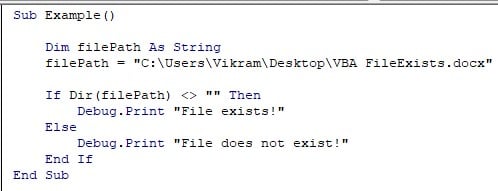What is VBA FileExists Function?
We use the VBA FileExists function to find out if a certain file exists in each place. If the file exists, it returns True; otherwise, it returns False. When working with file operations in VBA, this function is especially helpful because it enables developers to take different actions depending on whether a file is present or absent. Let us look at an example.

In this example, we are checking for a Word document named “VBA FileExists.docx” located at “C:\Users\Vikram\Desktop\VBA FileExists.docx.” The VBA FileExists function is called with the specified file path, and based on its return value, either “File exists!” or “File does not exist!” is printed to the Immediate window using “Debug.Print.”

Table of Contents
Key Takeaways
- The VBA FileExists function checks for the existence of a specified file.
- Use the “Dir” function for wildcards or FileSystemObject for more advanced file operations.
- When calling the VBA FileExists, it returns a Boolean value (True if the file exists, False if it doesn’t), enabling straightforward conditional logic in your code based on the existence of the file.
- Incorporating the VBA FileExists with user input mechanisms like InputBox fosters interactive VBA applications, allowing users to verify the existence of specific files and take appropriate actions based on the result.
Excel VBA 5-in-1 Course Bundle – (30+ Hours of Expert-Led Training)
If you want to learn Excel and VBA professionally, then the Excel VBA 5-in-1 Course Bundle (30+ hours) is the perfect solution. Whether you’re a beginner or an experienced user, this bundle covers it all – from Basic Excel VBA to Event Automation, Error Handling, Email Automation, and real-world applications with downloadable templates.
Syntax
The syntax of the VBA FileExists function is straightforward.
FileExists(PathName As String) As Boolean
- PathName: Specifies the path and name of the file you want to check.
How to Use VBA FileExists Function?
Using the FileExists function in VBA involves a few simple steps.
Step 1: Open Excel and press ALT + F11 to open the VBA editor.

Step 2: Insert a new module by clicking on “Insert” in the menu and selecting “Module.”

Step 3: Begin by declaring variables to hold the file path and the result of the FileExists function.
For example:
Dim filePath As String
Dim fileExistsResult As Boolean
Step 4: Assign the file path to the filePath variable, specifying the location of the file you want to check for existence.
For instance:
filePath = “C:\Example\File.txt”
Step 5: Call the FileExists function, passing the file path as an argument. This function will return a Boolean value indicating whether the file exists or not.
For example:
fileExistsResult = FileExists(filePath)
Step 6: Once the result is obtained, you can proceed based on whether the file exists or not. Typically, this involves using conditional statements such as If…Else.
For instance:
If fileExistsResult Then
‘ File exists, perform desired actions
MsgBox “File exists!”
Else
‘ File does not exist, handle accordingly
MsgBox “File does not exist!”
End If
Step 7: Execute the macro either by pressing F5 or clicking Run from the menu.
Examples
Let’s explore a few examples to understand how to use the VBA FileExists function effectively.
Example #1
In this example, we will see how to use a custom-defined VBA FileExists function to display a message box indicating whether a file exists at the supplied path.
Step 1: First, declare a function named FileExists that accepts a file path as input and returns True if the file exists and False otherwise.

Step 2: Next, we use the Dir(filePath) function to check if a file exists at the specified path.

Step 3: Once the function is created, we will now declare a new subroutine and then declare a Boolean variable in VBA named FileExistsResult to store the result of the FileExists function.

Step 4: We call the FileExists function with the specified file path in this line.
The function checks if the file exists at the given location and returns either True or False, which is then stored in the FileExistsResult variable.

Step 5: Next, we check the value of FileExistsResult. If it’s True, meaning the file exists, then this line displays a message box with the text “File exists!”.

Step 6: If the value of FileExistsResult is False, meaning the file does not exist, this line displays a message box with the text “File does not exist!”.

Step 7: Save the VBA macro. When you run this code, it checks if the file “C:\Users\Vikram\Desktop\VBA FileExists.docx” exists. If it does, it displays a message box saying, “File exists!”. If it doesn’t exist, it displays a message box saying, “File does not exist!”

Here is the full code:
Function FileExists(filePath As String) As Boolean
FileExists = Dir(filePath) <> “”
End Function
Sub Example1()
Dim fileExistsResult As Boolean
fileExistsResult = FileExists(“C:\Users\Vikram\Desktop\VBA FileExists.docx”)
If fileExistsResult Then
MsgBox “File exists!”
Else
MsgBox “File does not exist!”
End If
End Sub
Example #2 – DIR with IF Condition
In this example, we will see how to utilize the built-in Dir function to fetch a file at the given path, check if it exists, and display a message box with that information.
Step 1: First, we declare a new subroutine named “Example2.”

Step 2: This line declares a variable named filePath of type String to store the file path.

Step 3: In this step, we use the “Dir” function to check if a file exists at the specified path. If Dir returns a non-empty string, it means the file exists.

Step 4: Now, we will use the message box function to display the result.
- MsgBox “File exists!”: If the file exists, this line displays a message box with the text “File exists!”.
- MsgBox “File does not exist!”: If the file does not exist, this line displays a message box with the text “File does not exist!”.

Step 5: When you run this code, it checks if the file specified by the filePath variable exists. If it does, it displays a message box saying, “File exists!”. If it doesn’t exist, it displays a message box saying, “File does not exist!”.

Here is the full code:
Sub Example2()
Dim filePath As String
filePath = “C:\Example\File.txt”
If Dir(filePath) <> “” Then
MsgBox “File exists!”
Else
MsgBox “File does not exist!”
End If
End Sub
Example #3
In this example, we ask the user for the file location and then use the Dir function in VBA to determine whether the given file exists before displaying the outcome in a message box.
Step 1: After we create the new subroutine, two variables, “inputFile” and “fileExistsResult” are declared.
“inputFile” will store the user-input file path, while “fileExistsResult” will store the result of the Dir function.

Step 2: In this step, we provide an input box to appear, prompting the user to enter the path to the file they want to check for existence. The entered file path is stored in the variable inputFile.

Step 3: Similar to the previous example, the Dir function is used to check if the file specified by inputFile exists.
The result, which is the file name if it exists or an empty string if it doesn’t, is stored in the variable fileExistsResult.

Step 4: We use the message box function to display the result of the file existence check based on the value of fileExistsResult.
- If fileExistsResult is not empty, indicating that the file exists, the message “This File Exists” is shown.
- Otherwise, if fileExistsResult is empty, indicating that the file does not exist, the message “This File Does Not Exist” is shown.

Step 5: When you run this code, an input box in VBA will prompt you to enter the path to the file you want to check for existence.

After entering the file path, the code will use the Dir function to determine if the file exists. Then, it will display a message box indicating whether the file exists or not based on the result of the Dir function.

Here is the full code:
Sub CheckFileExists()
‘ Declare variables
Dim inputFile As String
Dim fileExistsResult As String
inputFile = InputBox(“Check if this file exists:”)
fileExistsResult = Dir(inputFile)
If fileExistsResult <> “” Then
MsgBox “This File Exists”
Else
MsgBox “This File Does Not Exist”
End If
End Sub
Important Things To Note
- Ensure that the file you are checking for existence has appropriate access permissions set. If the file is inaccessible due to permission restrictions, the VBA FileExists function may not accurately determine its existence.
- There are no restrictions on the length of the file path that can be checked using the VBA FileExists.
- Ensure that the file path provided to the VBA FileExists function is accurate and correctly formatted. Any errors or inaccuracies in the file path may lead to incorrect results in the file existence check.
- The VBA FileExists function is not case-sensitive.
- The VBA FileExists function does not accommodate wildcard patterns for file path matching, including the VBA fileexists wildcard searches.

Frequently Asked Questions (FAQs)
The file does not need to be open to use the VBA FileExists function. It doesn’t need to open or access the file; it just verifies if the requested file is present at the supplied location.
When you need to confirm that a file exists before carrying out any additional actions on it, such as reading, writing, or editing its contents, this function comes in handy.
No, the purpose of the VBA FileExists function is to verify if files exist, not directories. Use other methods like Dir or FileSystemObject if you need to find out if a directory exists at a given location.
These techniques offer the ability to conduct different operations on directories and verify their presence.
The length of the file path that can be verified with the VBA FileExists function is usually unrestricted. It is imperative to consider any constraints imposed by the operating system or file system underneath.
The ability to inspect files with very long paths may be impacted by maximum path length restrictions on some file systems.
No, using wildcards for pattern matching is not supported by the VBA FileExists method. It is not intended to match patterns; rather, it is meant to verify whether a particular file exists at a specified location.
You would need to look into other VBA functions or libraries that provide such capabilities, like the Dir function if you need to do wildcard-based searches or pattern matching.
No, there is no case sensitivity with the VBA FileExists function. Regardless of the case used in the input, it handles paths and file names equally.
This means that the function will correctly determine the presence of the supplied file regardless of whether you specify the file path in uppercase, lowercase, or a combination of both.
Recommended Articles
Guide to VBA FileExists Function. Here we explain how to use VBA FileExists function, along with examples & downloadable excel template. You can learn more from the following articles –

Leave a Reply